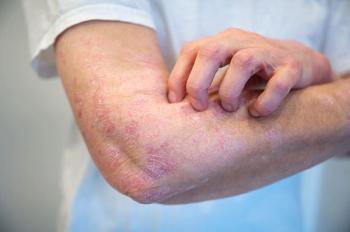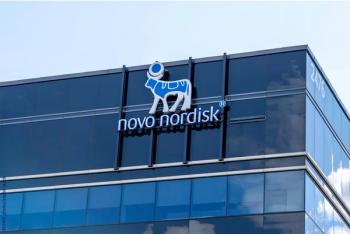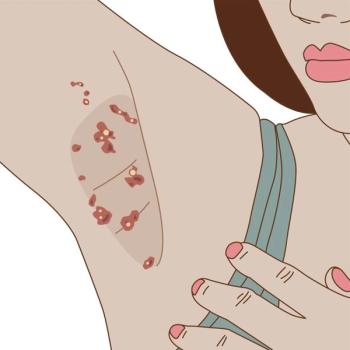
Cerebral Phaeohyphomycosis Caused by Fonsecaea monophora in a Renal Transplant Patient
Fonsecaea species have been reported as causative agents ofchromoblastomycosis, eumycetoma, and fungal pneumonitis.However, Fonsecaea rarely involves the CNS, with few cases ofcerebral infection reported in the literature. Fonsecaea monophoramay have greater neurotropic potential than other species ofthis genus. We describe a rare presentation of brain abscesscaused by F monophora in an immunocompromised renaltransplant patient. [Infect Med. 2008;25:469-473]
Phaeohyphomycosis, which manifests as a variety of clinical syndromes, is caused by dematiaceous fungi. One such manifestion is chromoblastomycosis, which is a chronic infection of skin and soft tissue. It is characterized by the presence of sclerotic bodies. Another manifestation is eumycetoma, which is a chronic deep tissue infection that usually occurs in the lower extremities and is characterized by the presence of mycotic grains and sinus tracts. Other clinical presentations of phaeohyphomycosis include superficial colonization of the skin, keratitis, subcutaneous cyst formation, allergic sinus disease, and fatal disseminated infections, including brain abscess.1
The presence of melanin within the fungal cell wall may play a role in the pathogenic potential of dematiaceous fungi. Melanin, which has been shown to be an important factor in determining the virulence of other fungi, such Cryptococcus, Histoplasma, Paracoccidiodes, and Sporothrix, may confer an advantage in evading host defenses.2 Infection can occur through surgical contamination, trauma, or inhalation, and it can spread to distant sites, such as the heart (causing endocarditis) or the brain (causing fungal abscess).
Case report
A67-year-old African American man who had received a cadaveric kidney graft presented with a 2-day history of right-sided hemiparesis and a seizure episode. A CT scan of the brain revealed a 2-cm mass in the left frontal lobe, and MRI of the brain showed a ring-enhancing mass in the posterior left frontal lobe. The patient underwent craniotomy and resection of a left frontal brain mass. Pathological examination of the mass revealed focally necrotic tissue with acute and chronic inflammation and fibrotic response. The tissue was infiltrated with light brown septate hyphae and rare sclerotic bodies (Figure). Cultures revealed Fonsecaea species. DNA sequencing confirmed Fonsecaea monophora.
Figure -
Septate hyphaeand rare scleroticbodies were observedin necrotic tissue excisedfrom the patient's leftfrontal lobe.
The patient's immunosuppressive regimen consisted of prednisone 5 mg PO qd, tacrolimus 1 mg bid PO, and mycophenolate mofetil 250 mg PO bid. He also was receiving phenytoin at a dosage of 100 mg tid to control seizures. In light of the diagnosis of fungal brain abscess, prednisone was switched to dexamethasone during the perioperative period; eventually, the dosage was tapered down and the drug was discontinued. The tacrolimus also was discontinued to decrease the level of immunosuppression. Treatment with amphotericin B lipid complex (ABLC) in combination with voriconazole was started. After 7 days, the patient was transferred to the rehabilitation unit to improve his functional skills.
On arrival at the unit, the patient was alert and had mild right hemiparesis and mild cognitive deficits. Functional improvement was noted, but he had a focal seizure, necessitating adjustment in the phenytoin dosage. After 3 weeks, the patient was discharged to an outpatient facility to complete 6 weeks of ABLC and voriconazole therapy. An MRI scan showed a small residual lesion at follow-up 4 weeks after discharge.
Discussion
Primary phaeohyphomycosis of the CNS can occur in immunocompetent and immunocompromised persons. The clinical management of this infection is problematic because it responds poorly to standard antifungal therapy and requires debridement or surgical excision for cure. The hematogenous route is the most likely source of infection, presumably from an initial subclinical pulmonary focus associated with inhalation of pathogenic environmental dematiaceous fungi.
Twenty-four fungal species have been implicated in cerebral phaeohyphomycosis. Most of these species cause secondary cerebral infection following development of infection in other sites (most often the sinuses). Four species can be considered to cause primary neurotropic infection: Cladophialophora bantiana, Exophiala dermatitidis, Ramichloridium mackenziei and Ochroconis gallopavum.3 Fonsecaea infection usually causes lesions confined to the skin and subcutaneous tissue. The organism is ubiquitous in soil and usually gains access to the body cutaneously through a wound. Therefore, a history of exposure to soil or organic material is a risk factor for Fonsecaea infection.4 Invasion of underlying structures and metastatic spread to distant sites through the lymphatic vessels or via hematogenous dissemination is extremely rare. Cases of cerebral lesions caused by Fonsecaea pedrosoi with primary infection of the paranasal sinus and skin have been reported.
Isolation of Fonsecaea (particularly F monophora) from a cerebral abscess in the absence of cutaneous or adjacent paranasal disease, as described in our case report, suggests that this organism also may be a neurotropic dematiaceous fungus. The neuroinvasive property of Fonsecaea species appears to be relatively low. Felger and Friedman5 noted cerebral invasion in mice only after intracerebral inoculation. Cortisone and antibiotic medication were administered to encourage proliferation of spores that were introduced intravenously so that a virulent cerebral infection would develop. Polak6 obtained similar results when he inoculated mice that had been intravenously pretreated with cortisone with F pedrosoi, which resulted in a chronic infection characterized by black lesions in the skin and subcutis with sclerotic bodies resembling human chromomycosis and also lesions in the brain and other organs.
Because of the rarity of cerebral phaeohyphomycosis, there is no consensus concerning appropriate treatment. It is generally agreed that a combination of medical and surgical treatment is required.2,3,7,8 For a single brain abscess, surgical debridement is probably essential for cure. Although complete surgical removal of a brain abscess may not be possible, even partial debulking of the brain mass is helpful. In the case of brain abscess, it is probably wise to use adjunctive medical therapy.
Polyene drugs demonstrate modest antifungal activity in vitro against dematiaceous fungi. They have been used in treatment of some disseminated infections. The azoles are commonly chosen in treatment strategies for phaeohyphomycosis because they exhibit moderate to excellent activity against dematiaceous fungi and can be given safely for long periods. Among the available agents, itraconazole and voriconazole have the most consistent and potent activity. Itraconazole poorly penetrates cerebrospinal fluid, although high levels of the drug are achieved in brain tissue.9 In contrast, voriconazole achieves good penetration of both cerebrospinal fluid and brain tissue.10
In vitro studies of drug combinations generally show either additive or synergistic activity. The initial antifungal regimen for this patient included ABLC, chosen because it is a broad-spectrum agent that penetrates the brain. Voriconazole was also selected because of its known activity against dematiaceous fungi and its clinical usefulness in cerebral phaeohyphomycosis. The level of immunosuppression was decreased, with adjustment of the corticosteroid and tacrolimus therapy. In this case, surgical excision, combined antifungal therapy with ABLC and voriconazole, and reduction of immunosuppression led to a relatively uneventful clinical recovery. After 6 weeks of combined therapy, voriconazole was then continued for several months to eliminate any residual infection.
References:
- Perfect JR, Schell WA, Cox GM. Phaeohyphomycosis. In: Dismukes WE, Pappas GP, Sobel JD, eds. Clinical Mycology. New York: Oxford University Press; 2003:271-282.
- Revankar SG, Sutton DA, Rinaldi MG. Primary central nervous system phaeohyphomycosis: a review of 101 cases. Clin Infect Dis. 2004;38:206- 216.
- Surash S, Tyagi A, De Hoog GS, et al. Cerebral phaeohyphomycosis caused by Fonsecaea monophora. Med Mycol. 2005;43:465-472.
- Mathisen GE, Johnson JP. Brain abscess. Clin Infect Dis. 1997;25:763-781.
- Felger CE, Friedman L. Experimental cerebral chromoblastomycosis. J Infect Dis. 1962;11:1-7.
- Polak A. Experimental infection of mice by Fonseca pedrosoi and Wangiella dermatitidis. Sabouraudia. 1984;22:167-169.
- Santosh V, Khanna N, Shankar S, et al. Primary mycotic abscess of the brain caused by Fonsecaea pedrosoi. Case report. J Neurosurg. 1995;82: 128-130.
- Nóbrega JP, Rosemberg S, Adami AM, et al. Fonsecae pedrosoi cerebral phaeohyphomycosis (“chromoblastomycosis”). First human cultureproven case reported in Brazil. Rev Inst Med Trop Sao Paulo. 2003;45:217-220.
- Groll AH, Piscitelli SC, Walsch TJ. Clinical pharmacology of systemic antifungal agents: a comprehensive review of agents in clinical use, current investigational compounds, and putative targets for antifungal drug development. Adv Pharmacol. 1998;44:343-500.
- Johnson LB, Kauffman CA. Voriconazole: a new triazole antifungal agent. Clin Infect Dis. 2003;36:630-637.
Newsletter
Enhance your clinical practice with the Patient Care newsletter, offering the latest evidence-based guidelines, diagnostic insights, and treatment strategies for primary care physicians.















































































































































































































































































